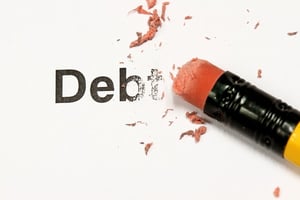 Just like there is good cholesterol and bad cholesterol, there is also good debt and bad debt. The average Minnesota household has about $134,000 in debt. But much of this debt is secured debt, like mortgages and auto loans. Most people do not mind paying these loans, as long as the terms are reasonable and they like the car, house, or other collateral.
Just like there is good cholesterol and bad cholesterol, there is also good debt and bad debt. The average Minnesota household has about $134,000 in debt. But much of this debt is secured debt, like mortgages and auto loans. Most people do not mind paying these loans, as long as the terms are reasonable and they like the car, house, or other collateral.
Credit cards, doctor bills, and other unsecured debt is another story. If this debt is less than $10,000, most people in Buffalo can pay it off within a few years. But if the debt load gets much higher, there is no way to pay it off, realistically speaking. Chapter 7 bankruptcy is a good option for these families, largely because it quickly wipes out most of the unsecured debts which befuddle families the most.
Credit Cards
Most credit card companies lend money freely and charge incredibly high interest rates. Some people occasionally splurge on their cards. But most of the charges they make are for basic living expenses or unexpected bills. Add these three things together, and many Minnesota families get into trouble with credit cards through no fault of their own.
Begin with lending practices. At Kain & Scott, we sometimes see clients with eight or ten cards from a single moneylender. When the debtor maxed out one, the company issued another one. Credit restrictions are annoying, but fundamentally, they’re in place to keep people from borrowing more than they can afford to repay. That restriction is often absent in credit card accounts.
Second, there’s the interest rate. Many cardholders take advantage of a “promotional” rate. This rate does not last forever, and there is often some sort of retroactivity clause buried in the fine print. Other people transfer balances to take advantage of low rates. The credit card company often conveniently forgets to point out that any additional purchases have an interest rate above market level.
Many people are forced to make high-interest credit card charges because their income stream goes dry for a few months. That’s all it takes to accumulate serious amounts of debt.
Medical Bills
There is considerable debate as to the number of medical bankruptcies. Some say it’s over 50 percent; others say it’s less than 5 percent. Assuming that the correct figure is somewhere in the middle, medical bills are among the leading causes of bankruptcy filings in Minnesota.
In Chapter 7, debtors can strategically pay some debts as agreed and allow other ones to be discharged. Some debtors worry about not being able to see their provider if they file a bankruptcy case and list the clinic as a creditor. That’s understandable, and the debtor might want to pay the medical bill (although there is no requirement that medical bills be paid). But if the creditor is a debt-buyer and the account is old, it’s usually better to let it go in bankruptcy. After all, that’s what this federally-sponsored debt relief program is for.
Student Loans
From about 1980 to 2000, it was not easy to discharge student loan debt in bankruptcy. Under the law at the time, a debtor basically had to have a disability, and that disability had to occur after the person borrowed the money, to obtain a discharge.
But that was before student loan debt began to mushroom. As a result of this crisis, many federal courts, including the Eighth Circuit, have adopted a more flexible totality-of-the-circumstances approach. Different courts have different tests. The Eighth Circuit typically uses a three-prong approach, which involves calculating:
- The debtor’s past, present, and likely future financial resources,
- Reasonable necessary living expenses of the debtor, and
- Any other factors the court considers relevant.
Because of this more flexible test, bankruptcy debtors in the Eighth Circuit, which includes Minnesota, have a chance to receive at least a partial student loan discharge.
Back Taxes
There are also specific rules with regard to back taxes with the IRS or Minnesota Revenue. These rules are not nearly as flexible, but the do apply to many cases. To discharge taxes in a Chapter 7 or Chapter 13, the debt must satisfy the following requirements:
- Three Years: The tax return for the year in question must have been due at least three years before filing. Tax Day is not always April 15, so consider that when making this calculation.
- Two Years: Your returns must have been on file for at least two years. So, there is at least a two-year waiting period. These must be taxpayer-filed returns. The substitute returns which the taxing authorities file do not count.
- 240 Days: If the taxing authority has assessed the debt within the last 240 days, the debt is not dischargeable. “Assessment” usually means that the IRS or DOR has sent any correspondence that mentions the amount owed.
Bankruptcy eliminates debt but not the collateral consequences of that debt. So, if the taxing authority has filed a lien, we’ll help you deal with it separately.
If you need a way to get rid of bad debt and get back on track, bankruptcy is the answer you’re looking for. To get a free consultation with an experienced bankruptcy attorney in Minnesota, contact Kain & Scott. We have nine offices statewide.


